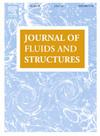Effect of structural parameters on the synchronization characteristics in a stall-induced aeroelastic system
IF 3.4
2区 工程技术
Q1 ENGINEERING, MECHANICAL
引用次数: 0
Abstract
This study focuses on discerning the role of structural parameters on the bifurcation characteristics and the underlying synchronization mechanism in an aeroelastic system undergoing nonlinear stall behaviour. To that end, wind tunnel experiments are performed on a NACA 0012 airfoil capable of undergoing bending (plunging) and torsional (pitching) oscillations under scenarios involving nonlinear aerodynamic loads, i.e., dynamic stall conditions. Flow conditions under both deterministic/sterile flows and fluctuating/stochastic flows are fostered. The structure possesses continuous or polynomial-type stiffness nonlinearities and therefore is an aeroelastic experiment involving both structural and aerodynamic nonlinearities. We discern the bifurcation routes for a range of key structural parameters, such as frequency ratio, static imbalance, and the extent of structural nonlinearity. In addition to interesting and atypical routes to stall-induced instabilities, we systematically demonstrate the role of modal interactions – via a synchronization analysis – over the manifestation of these instabilities. To the best of the authors’ knowledge, this is perhaps the first study to document the role of multiple structural parameters on a stall-induced aeroelastic system and in turn cast the physical mechanism behind these dynamical transitions through the framework of synchronization.
结构参数对失速气动弹性系统同步特性的影响
研究了气动弹性系统非线性失速时结构参数对系统分岔特性的影响及其同步机制。为此,在NACA 0012翼型上进行了风洞实验,该翼型能够在涉及非线性气动载荷(即动态失速条件)的情况下经受弯曲(俯冲)和扭转(俯仰)振荡。在确定性/无菌流动和波动/随机流动下培养流动条件。该结构具有连续型或多项式型刚度非线性,因此是一个涉及结构和气动非线性的气动弹性实验。我们识别了一系列关键结构参数的分岔路径,如频率比、静态不平衡和结构非线性程度。除了有趣的和非典型的失速诱导不稳定性的途径外,我们系统地展示了模态相互作用-通过同步分析-在这些不稳定性的表现中的作用。据作者所知,这可能是第一个记录多个结构参数在失速气动弹性系统中的作用的研究,并反过来通过同步框架揭示了这些动态转变背后的物理机制。
本文章由计算机程序翻译,如有差异,请以英文原文为准。
求助全文
约1分钟内获得全文
求助全文
来源期刊

Journal of Fluids and Structures
工程技术-工程:机械
CiteScore
6.90
自引率
8.30%
发文量
173
审稿时长
65 days
期刊介绍:
The Journal of Fluids and Structures serves as a focal point and a forum for the exchange of ideas, for the many kinds of specialists and practitioners concerned with fluid–structure interactions and the dynamics of systems related thereto, in any field. One of its aims is to foster the cross–fertilization of ideas, methods and techniques in the various disciplines involved.
The journal publishes papers that present original and significant contributions on all aspects of the mechanical interactions between fluids and solids, regardless of scale.
 求助内容:
求助内容: 应助结果提醒方式:
应助结果提醒方式:


